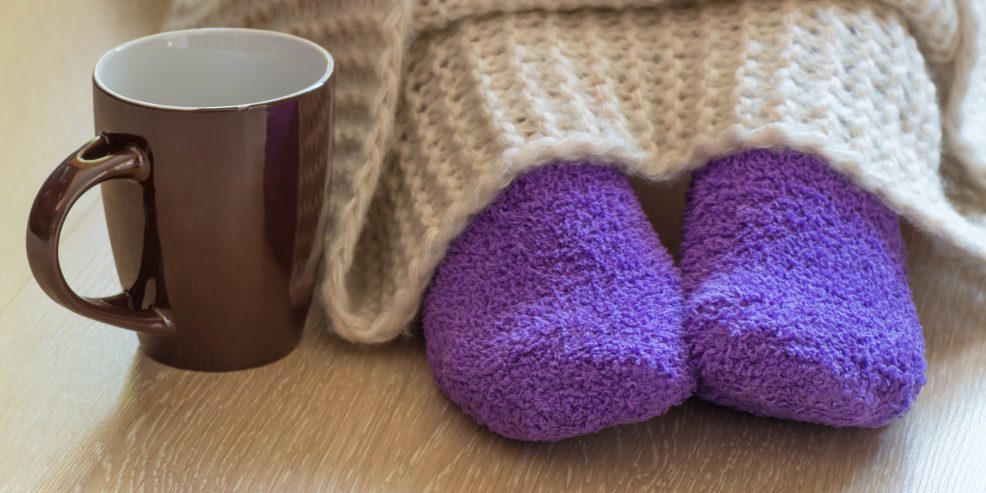If you’ve noticed that cold weather causes a sting to your nose or a bite to your toes while traveling over the river and through the wood this season, the pain could be telling you something.
Never Miss a Beat!
Subscribe to Our HealthBeat Newsletter!
Thank you for subscribing!
You can now select the specific newsletters you'd like to receive.
You are already subscribed.
Subscribe to more newsletters in our email preference center.
Sorry, an error occurred. Please try again later.
Get Healthy Tips Sent to Your Phone!
What is Raynaud’s Syndrome?
Raynaud’s phenomenon is a disorder of the small blood vessels in the extremities that presents itself as an extreme response and sensitivity to cold temperatures. Uncomfortable spasms in the blood vessels that feel like numbness, throbbing or tingling result from reduced blood flow and are triggered by temperature changes or stress. This response is much different from frequently the sensation of having cold hands and feet.
Extremities affected by Raynaud’s, such as fingers, toes, nose or ears, typically change color, from white to blue to red, as they are exposed to cold and then heat. In comparison, normal fingertips turn blotchy red and white when warming up after being exposed to cold temperatures. What causes or cures Raynaud’s isn’t known, but it is important to seek treatment to prevent long-term damage. Raynaud’s affects about five percent of the U.S. population, but statistics show that only one-in-five people who suffer from the condition seek treatment.
Raynaud’s is classified into two categories: primary and secondary. Primary Raynaud’s is the most common and is not associated with an underlying condition. Still, sufferers must deal with pain and discomfort, which can be reduced conservatively with lifestyle changes. Secondary Raynaud’s is less common and is often the first indicator of an underlying connective tissue disease, such as Lupus, Scleroderma or Sjӧgren’s. Without treatment, secondary Raynaud’s can result in painful complications, such as skin ulcers, and even gangrene.
If you suspect you may be suffering from Raynaud’s, the best first step to take is to schedule an appointment with your primary care doctor or a rheumatologist. After a physical examination and a thorough health history, the doctor will determine whether a blood screening is needed. Most of the time, a blood screening is all that is needed to determine whether the syndrome is primary or secondary, and what treatments are best for the patient.
If the disease is primary, the patient will be instructed in methods used to stay warm and comfortable, such as wearing gloves when removing items from the freezer, keeping core temperatures up by wearing a vest or employing better techniques for managing stress. Occasionally, blood pressure medications called calcium channel blockers or blood thinners like aspirin are prescribed. A primary Raynaud’s patient whose condition has not progressed into another medical problem in five years is unlikely to develop any other serious complications. Patients with secondary Raynaud’s are treated similarly to those with primary, with the addition of specific medications to address the underlying disorder.
Anyone who experiences instances in which the color isn’t returning to affected extremities, especially when pain is excessive or there are ulcers on the fingertips, should report directly to the emergency room for care. In such cases, blood vessels might be blocked and immediate attention is needed. For additional information about Raynaud’s, talk with your primary care doctor and ask for a referral to UPMC Susquehanna’s Rheumatology.
Alicia Meadows, D.O., is a rheumatologist at UPMC Susquehanna. She earned her medical degree at Philadelphia College of Osteopathic Medicine and completed her residency at Geisinger Medical Center. Dr. Meadows is fellowship trained in Rheumatology.
About UPMC
Headquartered in Pittsburgh, UPMC is a world-renowned health care provider and insurer. We operate 40 hospitals and 800 doctors’ offices and outpatient centers, with locations throughout Pennsylvania, Maryland, New York, West Virginia, and internationally. We employ 4,900 physicians, and we are leaders in clinical care, groundbreaking research, and treatment breakthroughs. U.S. News & World Report consistently ranks UPMC Presbyterian Shadyside as one of the nation’s best hospitals in many specialties and ranks UPMC Children’s Hospital of Pittsburgh on its Honor Roll of America’s Best Children’s Hospitals. We are dedicated to providing Life Changing Medicine to our communities.
